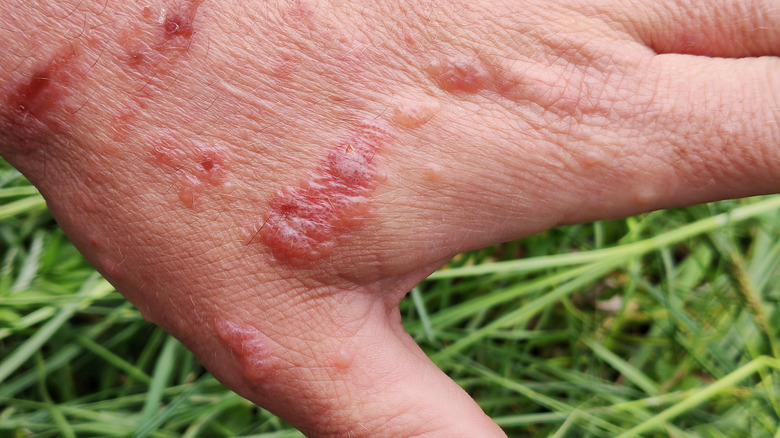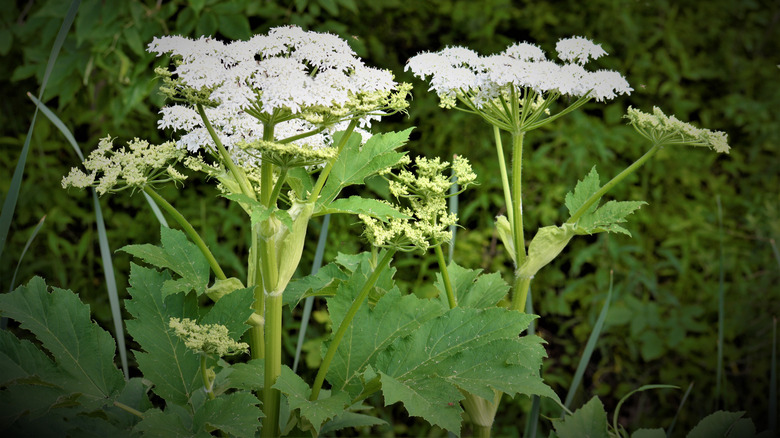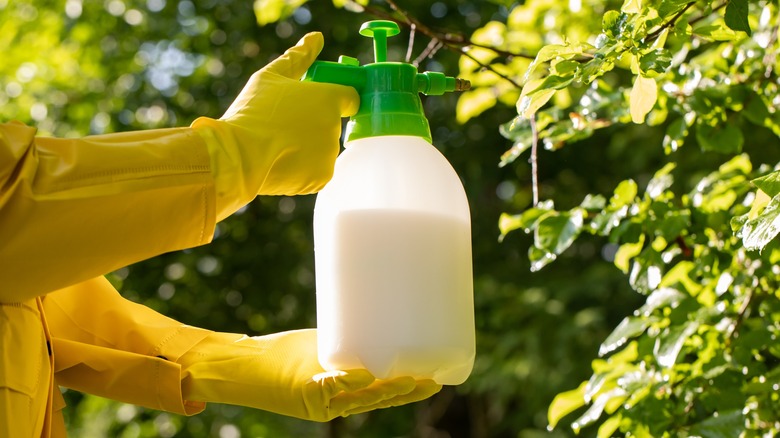The Supersized Weed That Is Very Dangerous In Your Yard
Originally from Eurasia, giant hogweed (Heracleum mantegazzianum) was imported into the American heartland for ornamental planting. It has since spread to stream banks, tree lines, and yards. This plant is notorious for shading out and outcompeting native vegetation, adversely affecting wildlife habitats. It has earned a spot on the USDA invasive species list. But there is another reason to dread this supersized weed – it puts public health in peril with its toxic sap.
Unlike other plants that cause skin irritation, giant hogweed doesn't affect people as they brush past it. Instead, the invasive weed requires three things before it becomes dangerous to humans (animals are impervious). First, the plant must become damaged for the sap to ooze out — be aware of cut stems, crushed leaves, or trodden flowers. Second, the sap must touch moist or sweaty skin. Then, that skin must be exposed to sunlight, which activates the inflammation-causing chemical — furanocoumarin — in giant hogweed's sap.
When these three play out simultaneously, the weed causes a reaction called phytophotodermatitis, leaving burns, blisters, and purplish-black scars in its wake. It can take up to six years to heal. Accidental eye contact may also lead to temporary — or, rarely, sometimes permanent — blindness. Worse, the infection may not be obvious immediately, sometimes taking three days to show up. When exposed, rinse the area with water and soap and keep the skin covered for two days until the toxins have worn off. Seek medical assistance where necessary.
Does your yard contain giant hogweed?
Giant hogweed is often misidentified. Cow parsnip, water hemlock, poison hemlock, and wild parsnip often get mistaken for the invasive weed (although they're equally scary and should be destroyed right away). Conversely, some mistake these deceiving weeds for flowers like Queen Anne's Lace, as both boast umbels of white flowers, albeit hogweed's clusters are far larger. However, the easiest way to avoid any misidentification is to focus on size. Giant hogweed was named after Hercules — a mythological Roman hero famous for his size and strength — due to being massive on all fronts, from height to the size of its foliage and flowers.
Standing 15 to 20 feet tall, giant hogweed towers over most plants. It combines 5-foot wide, irregularly notched, compound leaves with coarse white bristles clumping around its leaf stalks. Its green stalks are similarly impressive, measuring 15 feet tall and 4 feet across. Another tell-tale sign is that its hollow stems are smattered in purple blotches, in sharp contrast to the uniform coloring on its doppelgangers. Hardy to zone 3, it's mostly concentrated in moist soils of eastern and northwestern regions, such as Michigan, Virginia, Pennsylvania, New York, Montana, and Oregon.
What should you do if a giant hogweed is growing in your yard?
Once you've confirmed that the beautiful specimen growing in your yard is the hazardous giant hogweed, contact your local county's environmental agency or weed control specialists for possible remediation. Their experts usually follow cultural control measures, such as flowerhead removal (before the plant seeds) and root-pulling in small areas. However, larger infestations (over 400 plants) may call for herbicide control.
In the meantime, avoid approaching the plant unless fully clothed and wearing eye protection and gloves. Don't remove the weeds mechanically, lest the toxic sap splashes onto your skin. But if you find any seeds, destroy them to prevent germination. Further, skip mowing the yard unless you're up for carrying out the chore frequently. The initial mow will work counterintuitively, stimulating new growth, but successive trips will eventually succeed in drawing down its food reserves, killing the weed. Rototilling the yard might work, too. Finally, don't forget to wipe down your shoes, mower, or lawn equipment to minimize the risk of spreading seeds.


